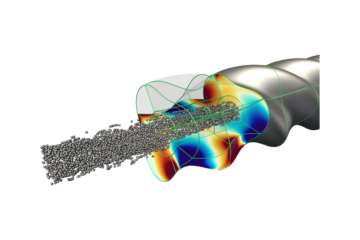Due to their advantages, numerical gas flow and plasma simulations have become valuable tools for industry professionals to better understand complex systems and optimize their designs. These simulations involve using advanced computer algorithms to create detailed models of gas and plasma behavior.
Digitization of product development & optimization
One of the primary advantages of using numerical gas flow and plasma simulation is that it allows engineers to test and optimize designs before physical prototypes have to be manufactured. This saves time and money, and also allows engineers to explore a wider range of design options and identify potential issues before they become more expensive to fix. For example, numerical simulations can be used to model the gas flow through a turbomolecular or molecular drag pump utilized in vacuum systems. By analyzing the flow patterns and pressure distributions, engineers can identify areas where the design can be optimized to increase efficiency, and minimize wear on the components (Example: Kinetic Simulation of a Molecular Drag Pump). Similarly, numerical simulations can be used to model the behavior of plasmas in various industrial processes, such as vacuum plasma coating (Example: DC magnetron sputtering). These simulations can provide insights into the plasma’s behavior and help engineers optimize the process for greater precision, efficiency, and safety.

Example simulation result: DC magnetron sputtering
Detailed physical insights & parametric studies
Another advantage of simulations is that they allow engineers to model and analyze systems that would be difficult or impossible to study through physical experiments alone. For example, numerical simulations can be used to study the behavior of fluids in microfluidic systems or plasma interactions at the molecular level, where experimental measurements can only be inferred or are not feasible at all (Example: Gyrotron resonator devices). Furthermore, simulations can be used to study the effects of different variables on system performance, such as changes in mass flow, temperature, and/or pressure. This can help engineers design systems that can operate under a wider range of conditions and improve their overall reliability.
Save cost & time by reducing the number of prototypes
In conclusion, numerical gas flow and plasma simulations are powerful tools that offer many advantages for industries utilizing vacuum systems, vacuum coating processes and plasma processes in general. By providing detailed insights into the behavior of complex systems, engineers can optimize their designs for greater efficiency, reliability, and safety, while also saving time and money by reducing the number of expensive test campaigns and prototypes. With the continued development of these simulation technologies, we can expect to see even more widespread use of these tools in the years to come.
One of these tools is our open-source plasma simulation software PICLas. If you are interested how numerical gas flow and plasma simulations can be applied to your application, please contact us!


